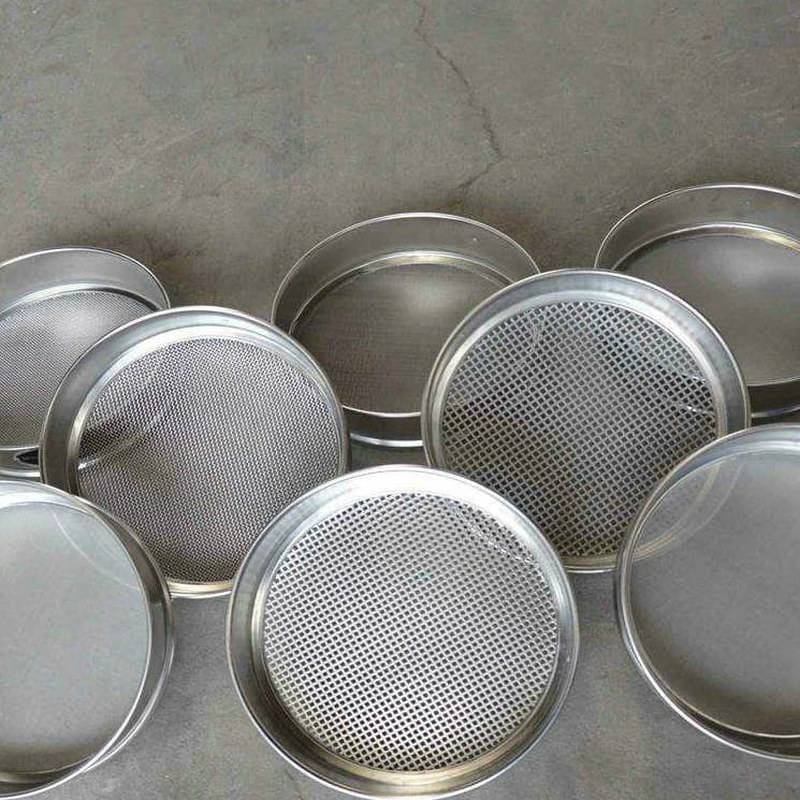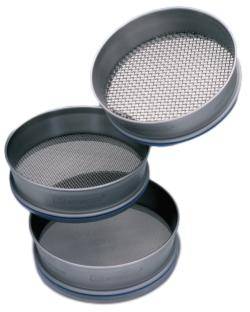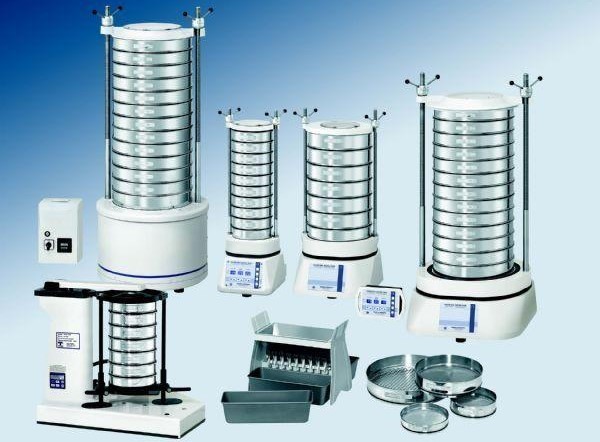1. Throw-Action Sieving

Throw-action sieving is a specific method used in sieve analysis to divide granular materials into size fractions. This technique involves the use of throw-action sieving machines, which employ both vertical and circular motions to distribute the sieving sample evenly across the sieving surface.
Principles of Throw-Action Sieving
Throw-action sieving machines utilize a vertical throwing motion that is overlaid with a slight circular motion. This combination of motions results in the acceleration of particles in a vertical direction. As the particles undergo free rotations in the air, they have the opportunity to change positions and potentially pass through the sieve meshes, even if their size initially appears to be larger than the mesh openings.
When smaller particles are present in the sample and they are smaller than the mesh openings, they fall through the sieve effortlessly. However, particles that are longer in their length and cannot pass through the mesh may be vertically accelerated and change their direction, allowing them to pass through the sieve if they have a smaller width.
Advantages of Throw-Action Sieving
Throw-action sieving offers several advantages that make it a popular method for sieve analysis:
-
Efficient Particle Distribution: Throw-action sieving machines ensure that the sieving sample is evenly distributed across the entire sieving surface. This allows for a more representative analysis of the particle size distribution.
-
Separation of Size Fractions: The vertical and circular motions of throw-action sieving machines aid in separating the different size fractions present in the sample. This can be particularly useful when analyzing granular materials with a broad particle size spectrum.
-
Quick and Reliable Analysis: Throw-action sieving provides a relatively fast and reliable analysis of the particle size distribution. This can be advantageous in industries where timely results are crucial for quality control and process optimization.
Limitations of Throw-Action Sieving
While throw-action sieving has many advantages, it also has some limitations:
-
Size Limitations: Throw-action sieving may not be suitable for samples with extremely large particles that cannot be accommodated by the sieve mesh openings. In such cases, other methods of particle size determination may be more appropriate.
-
Sample Characteristics: The effectiveness of throw-action sieving may vary depending on the characteristics of the sample, such as shape, density, and cohesion. Samples with irregular shapes or high cohesion may not be accurately analyzed using this technique.
-
Operator Skill: The proficiency of the operator can influence the accuracy and repeatability of throw-action sieving. Proper training and adherence to standardized procedures are important to obtain reliable results.
In summary, throw-action sieving is a widely used method in sieve analysis that offers efficient particle distribution and separation of size fractions. It is a quick and reliable technique, although it has limitations with regard to sample size and characteristics. By understanding the principles and considerations of throw-action sieving, researchers and professionals can effectively utilize this method to assess the particle size distribution of granular materials.
2. Single Sieve and Sieve Set Sieving

This section will explore the use of single sieve and sieve set sieving methods. We will explain how a single sieve is used to determine the percentage of undersize and oversize particles, while sieve set sieving involves a stack of sieves and a collector pan. We will discuss the purposes and applications of both methods.
Single Sieve Sieving
A single sieve is a simple and effective tool used in particle size analysis. It consists of a wire mesh with uniform openings and a frame to hold the mesh in place. The sieve is placed over a container, and a sample of material is poured onto the sieve. The material is then shaken or tapped gently to allow particles smaller than the sieve openings to pass through, while larger particles are retained on top of the sieve.
The percentage of undersize and oversize particles can be determined by weighing the material retained on the sieve and comparing it to the total weight of the sample. This information is useful for quality control purposes, as it helps ensure that the material meets desired size specifications.
Single sieve sieving is most commonly used for coarser materials, typically ranging from 150 µm to several millimeters in size. It is relatively quick and easy to perform, making it a popular choice in many industries.
Sieve Set Sieving
Sieve set sieving involves the use of a stack of sieves with varying mesh sizes. The sieves are arranged in order from largest to smallest openings, with a collector pan placed at the bottom of the stack to collect the particles that pass through the finest sieve.
The sample is poured onto the top sieve of the stack, and the entire stack is then placed in a sieve shaker. The sieve shaker agitates the stack, causing the particles to move and fall through the openings of each sieve. The particles are separated by size, with the largest particles retained on the top sieve and the finest particles captured in the collector pan.
Sieve set sieving allows for a more detailed analysis of particle size distribution compared to single sieve sieving. By using multiple sieves with different mesh sizes, a broader range of particle sizes can be captured and analyzed. This method is commonly used for fine and ultra-fine materials, typically ranging from 50 µm to a few micrometers in size.
Purpose and Applications
The purpose of both single sieve and sieve set sieving methods is to determine the particle size distribution of a given material. This information is crucial in many industries, including pharmaceuticals, food and beverage, mining, and construction.
By understanding the particle size distribution, manufacturers can ensure that their products meet desired specifications and performance requirements. For example, in the pharmaceutical industry, the particle size of a drug can affect its absorption rate and bioavailability. In the food industry, the particle size of ingredients can impact the texture and taste of the final product.
Single sieve sieving is commonly used in industries that deal with coarser materials, such as aggregates, sands, and granular materials. It provides a quick and straightforward method for quality control and process optimization.
Sieve set sieving, on the other hand, is suitable for finer materials, including powders and fine particles. It allows for a more detailed analysis of the particle size distribution, which is often required for research and development, product design, and troubleshooting purposes.
In conclusion, single sieve and sieve set sieving methods are valuable tools in particle size analysis. They allow for the determination of particle size distribution and play a critical role in quality control and product development across various industries. Whether using a single sieve or a stack of sieves, these methods provide valuable insights into the characteristics of materials and help manufacturers ensure the consistency and performance of their products.
3. Dry and Wet Sieving

In this section, we will delve into the differences between dry and wet sieving. We will explain why most sieving processes are carried out on dry materials, but also highlight scenarios where wet sieving is necessary. We will explore the setup and process for both dry and wet sieving, emphasizing the importance of maintaining the integrity of the sample.
What Are Sieves Used For?
Sieves are widely used in laboratory settings for testing various substances such as chemicals, powders, oils, and fluids. These tests provide valuable information about contaminants, byproducts, defects, and particle density. By utilizing test sieves, researchers can gain insights into multiple attributes of materials in the production process. The use of sieves can lead to improvements in product quality, operational efficiency, and equipment maintenance.
For instance, dry silica sand can be easily analyzed for separations down to 50 microns using most sieve shakers. However, if the material tends to clump or agglomerate, a shaker that provides periodic vertical shocks to the stack will yield better results. In cases where the material exhibits high static electricity, alternative methods such as wet sieving may be required.
In situations where the particles to be separated are smaller than 50 microns, other techniques may be needed for effective separation. Ultrasonic agitation techniques can often be employed. Another method involves the use of a vacuum to pull small particles through the sieve openings. However, vacuum equipment typically processes one sieve at a time.
Dry Sieving
Dry sieving is the most commonly used method due to its simplicity and efficiency for a wide range of materials. This process is suitable for samples that do not contain excessive moisture or tend to agglomerate when wet. Dry sieving involves placing the sample on the top sieve of a sieve stack, clamping the stack onto a sieve shaker, and initiating the sieving motion. The shaker's vibrations help to pass the particles through the sieve meshes, separating them according to size.
To ensure accurate results, it is important to properly prepare the sample for dry sieving by removing any large particles or debris that may affect the sieving process. Additionally, the sieves should be regularly inspected for wear and tear to maintain the integrity of the results.
Wet Sieving
While most sieve analyses are carried out using dry sieving, there are certain applications that require wet sieving. Wet sieving is necessary when the sample to be analyzed is a suspension that must not be dried or when the sample is a very fine powder that tends to agglomerate, making dry sieving ineffective.
The setup for wet sieving is similar to dry sieving. The sieve stack is clamped onto the sieve shaker, and the sample is placed on the top sieve. However, in wet sieving, a water-spray nozzle is placed above the top sieve to support the sieving process in addition to the sieving motion. The sample is rinsed with water until the liquid discharged through the receiver is clear. Any sample residues on the sieves should be dried and weighed.
It is crucial to ensure that the sample does not undergo any changes in volume, such as swelling, dissolving, or reacting with the liquid used in wet sieving. This is important to maintain the integrity of the sample and obtain accurate results.
Wet Sieving Equipment
Any test sieve can be used for wet sieving, but wet-washing sieves are specifically designed to optimize the process. These sieves have deep frames to prevent spillage and drain holes, and some models even have replaceable mesh assemblies. Similar to conventional test sieves, wet-wash sieves are available in various mesh and frame material options. Stainless steel wet-wash sieves are a durable and corrosion-free choice for most applications.
To enhance convenience, a selection of wet sieving accessories is available. Aggregate washers, for example, automate the washing process by using water fed into a rotating, inclined drum to flush fines out over a sieve gently.
In conclusion, both dry and wet sieving have their respective advantages and applications. Dry sieving is widely used due to its simplicity and efficiency, while wet sieving is necessary for samples that cannot be dried or contain fine powders prone to agglomeration. By understanding the differences and requirements of these two methods, researchers can ensure accurate and reliable particle size analysis in their laboratory processes.
Related Products
- Laboratory Test Sieves and Vibratory Sieve Shaker Machine
- Laboratory Wet Three-Dimensional Vibratory Sieve Shaker Machine
- Laboratory Vibratory Sieve Shaker Machine Slap Vibrating Sieve
- Three-dimensional electromagnetic sieving instrument
- Vibratory Sieve Shaker Machine Dry Three-Dimensional Vibrating Sieve
Related Articles
- The Three Stages of Lab Crushing: A Comprehensive Guide
- Sieving technology for particle size analysis and its applications
- FTIR Pellet Press The Game-Changer in Spectroscopy Analysis
- The Scientific Principle of Sieving: Understanding Particle Size Distribution and Laboratory Test Sieves
- Three-Dimensional Vibrating Sieve: Working Principle and Application Fields










